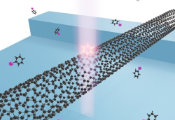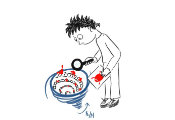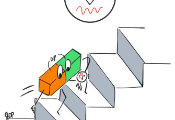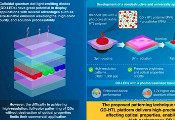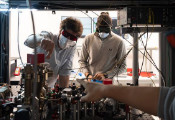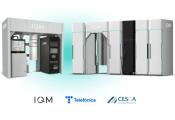Lighting the Way to Quantum Computing
December 19, 2024 -- Hsinchu, Taiwan, Quantum information can be carried in particles of light called photons. Single photon emitters that emit precisely one photon at a time are important components for many quantum technologies, including quantum computing.
However, it is challenging for a photon emitter to achieve high quantum efficiency – the ability of the device to emit a photon on demand. It is also difficult to have high collection efficiency, meaning the emitted photon is easily collected and routed for application.
Using ultrathin two-dimensional (2D) materials that are one atom thick, a team of researchers led by Prof Gao Weibo of NTU’s School of Electrical and Electronic Engineering (EEE) and School of Physical and Mathematical Sciences (SPMS) has devised photon emitters that reached a quantum efficiency of 76.4% on average and more than 90% for some, approaching what is known as a unity quantum efficiency of 100%. Prof Gao is also a President's Chair Professor in Physics at NTU and principal investigator at the Centre for Quantum Technologies (CQT).
This result is the first time that near unity quantum efficiency has been achieved in 2D materials.
The emitters are made by overlaying a 2D layer of tungsten diselenide (WSe2) on top of an array of gold pillars. To get a single photon from the 2D WSe2, the researchers first used a laser to generate excited particles called excitons. As an exciton decays back to its ground state, it undergoes either radiative or non-radiative decay. A photon is emitted only if the decay is radiative.
According to Dr Abdullah Rasmita, research fellow at NTU’s EEE, who was the co-first author of the research paper together with Dr Cai Hongbing, research fellow at the Centre for Disruptive Photonics Technologies at NTU, near-unity efficiency can be achieved if the probability of non-radiative decay is close to zero.
To suppress non-radiative decay, the researchers applied an electric field to separate positive and negative charges from the exciton. This depletion of charges enabled the device to achieve near-unity efficiency.
“Our on-demand quantum emitter is desirable for many applications, including quantum communications and scalable optical quantum computation,” said Prof Gao.
Putting the brakes on light
Slowing down the speed at which light travels is also vital for quantum information processing as it enables quantum information encoded in photons, known as qubits, to be processed effectively.
Photonic chips are usually used to slow down light. Light passing through the chip interacts with it and slows down. However, light is frequently backscattered in conventional photonic chips due to diffraction – the bending of light as it passes around corners or through narrow openings. The slower the light is, the more backscattering it suffers. This limits the range of frequencies that can be used for slow light, reducing its transmission efficiency.
To address this drawback, researchers co-led by Prof Zhang Baile of NTU’s SPMS proposed a design strategy in 2021. This year, building on that idea, they have developed a chip that enhances light-matter interactions, slowing down light without backscattering over a wide range of frequencies.
Using an electromagnetic material called a photonic Chern insulator, they demonstrated that light could be slowed down over a broad range of frequencies. Like water swirling down a drain, the light winds around points in the imaginary space of the crystal lattice of the material, known as Brillouin zones, which slows it down.
According to the researchers, the chip overcomes the limitations of conventional slow-light devices, enabling applications such as quantum memory, which is essential for quantum information processing.
Enhancing light-matter interactions at room temperature
In superconducting quantum circuits, the interplay between light and matter is critical for quantum information processing. However, these circuits are traditionally operated at ultra-low temperatures, requiring significant energy for cooling and resulting in high costs.
Now, researchers, co-led by Prof Wang Qi Jie of NTU’s EEE and SPMS and Assoc Prof Wei Lei of NTU’s EEE, have observed ultra-strong coupling between excitons in tungsten disulfide (WS2) flakes and surface plasmons at room temperature. Surface plasmons are generated when light interacts with electrons on a metal surface.
This is the first observation of such a phenomenon.
The team achieved this by transferring an ultrathin layer of WS2 onto an array of gold nanostructures with densely packed nanometre-sized gaps on a flexible polymer substrate. By applying mechanical strain, they successfully tuned the coupling strength between the WS2 excitons and the gold plasmons.
“Strong and stable light-matter interactions at room temperature open the door to quantum computing applications at ambient temperatures, reducing the stringent cooling requirements for quantum computers,” said Prof Wang.
“Our work could also pave the way for more exotic light-matter interactions and lead to new insights in fundamental science,” added Assoc Prof Wei.
Simulating molecules to discover new drugs
Light can also help quantum computers solve complicated problems, such as predicting the chemical properties of molecules to discover new drugs.
NTU scientists have devised a quantum processing chip that uses photons to deduce the chemical properties of molecules, opening the door to faster drug discovery.
Molecules vibrate, and each of their vibronic modes is associated with some energy levels. Understanding the probability that a molecule will transit from one level to another can uncover its chemical characteristics.
Prof Kwek Leong Chuan of NTU’s EEE and Prof Liu Ai Qun who was an NTU researcher at the time of the study, together with an international team of researchers, calculated these transition probabilities using the integrated photonic chip. As a proof-of-concept, they simulated the vibronic spectra of several molecules, including formic acid and thymine.
The researchers used a technique known as scattershot boson sampling to simulate the molecules’ vibronic spectra. In boson sampling, photons enter and travel through a circuit to output channels. As the photons travel, they interfere with each other in a way that can be programmed. By programming the circuit to simulate the vibronic modes of a molecule, the researchers could obtain the vibronic spectra by measuring the output distribution of the photons.
As quantum photonic chips provide greater computation power than classical computers, they are vital for solving larger molecules, said Prof Kwek, co-director of NTU’s Quantum Science and Engineering Centre and a professor at the National Institute of Education and NTU’s EEE. He is also a CQT principal investigator.
Another advantage of the chip is that it is compact and can operate at room temperature.
The researchers are now working on simulating complex molecules and studying the transitions between the excited states of a molecule.

